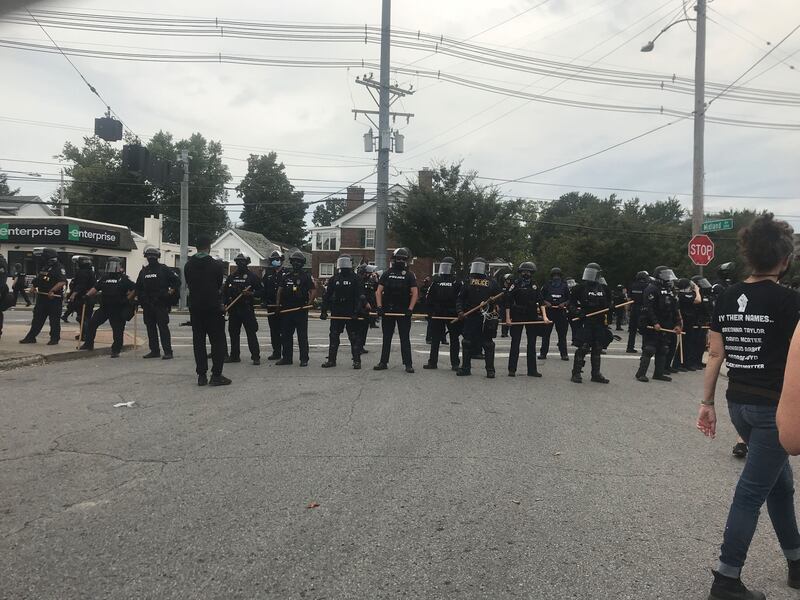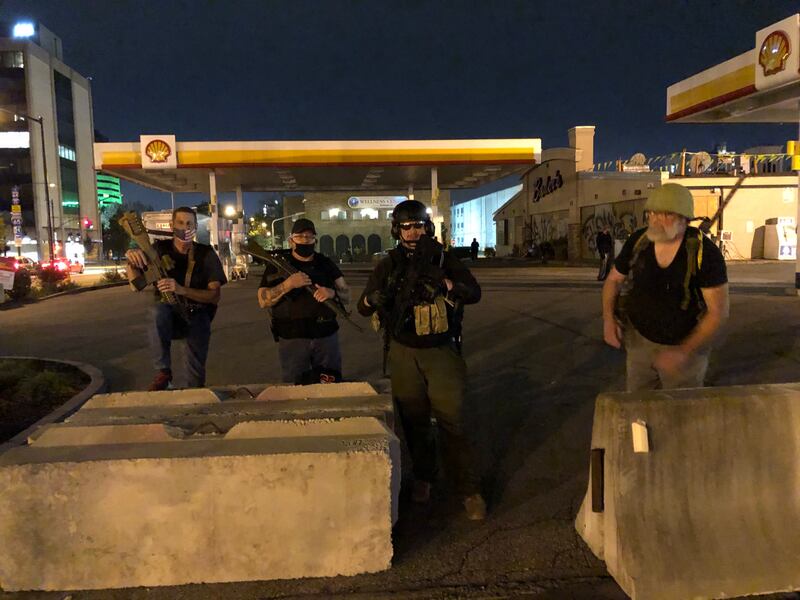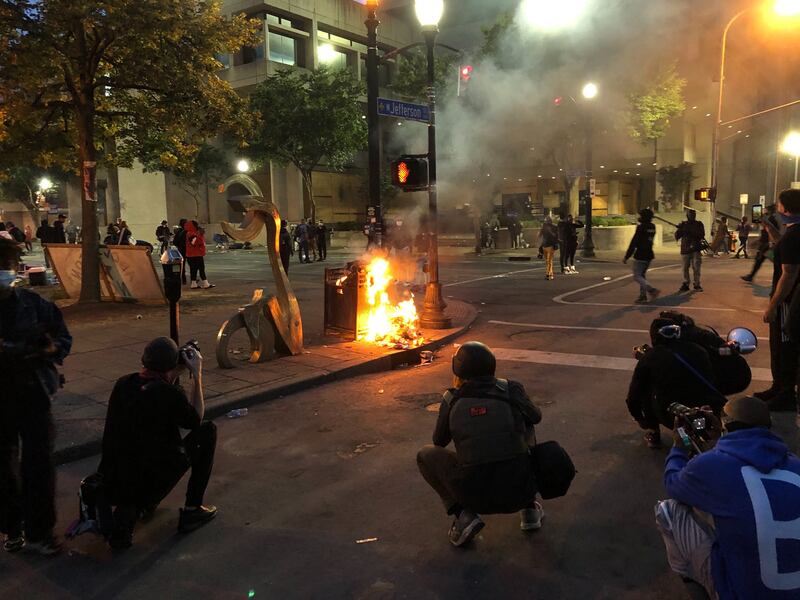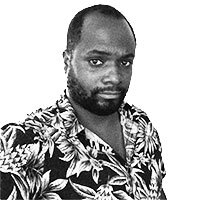LOUISVILLE—Just hours after three Louisville Metro Police officers dodged charges for the fatal shooting of 26-year-old Breonna Taylor in March, protesters took to the streets across the country in outrage, and at least two cops were shot in this city’s downtown.
Well before a curfew went into effect in Louisville, police had declared an unlawful assembly, dispensed pepper spray and flash bangs on protesters—some of whom hurled assorted objects at cops—and put out at least one fire on plywood at the Hall of Justice.
Hours earlier, in a stunning decision, a grand jury indicted one of the officers who took part in the attack on Taylor, former detective Brett Hankison, with three counts of wanton endangerment. But the charges stemmed from the shots Hankison fired—while serving a warrant at Taylor’s apartment in the middle of the night—that hit or endangered people in other units.
ADVERTISEMENT
In other words, the shots that killed the Black emergency medical technician, an icon of Black Lives Matter protests in recent months, were not deemed criminal. The two other officers, Jonathan Mattingly and Myles Cosgrove—the cop who fired the shot that killed Taylor—were not charged at all in an action that Kentucky Attorney General Daniel Cameron said “was justified to protect themselves.”
Hankison was booked at about 4:30 p.m. at the Shelby County Detention Center after turning himself in, a spokesperson for the jail told The Daily Beast. He was released about 30 minutes later after posting a bond for $15,000.
By then, the city was already consumed with grief and anger.

Beginning in Jefferson Square Park, which has served as the home base for Louisville Black Lives Matter protests over the last 118 days, residents started to march after Cameron’s Frankfort press conference. They called for justice for Taylor, chanting “No justice, no peace” and “Keep going.” Police cars took to trailing the activists, and in The Highlands, a gentrified, residential neighborhood of Louisville, hundreds of protesters, some throwing bottles, faced off with police before 4 p.m.
Police fired a volley of pepper balls, while a man used a wooden bat to try to break a UPS storefront. Protesters sat in a side parking lot with injuries they said stemmed from the law-enforcement onslaught. Some were taken into police custody.
Protesters were effectively boxed in by an aggressive early police presence, before venturing deeper into a residential neighborhood, chants of “Say her name” echoing in call and response.
Around nightfall, protesters lit a piece of plywood on fire at the Hall of Justice while officers declared an unlawful assembly and continued to warn about dispensing chemical agents—before going ahead and doing so. At least one fire was subsequently put out, but blazes erupted nearby on trash cans as protesters hurled trash at cops.
Shortly after 8 p.m., dozens of cops stormed Jefferson Square—renamed Injustice Square by protesters—in an apparent attempt to seize it, flash bangs piercing the air.

Around the same time, two city cops were shot downtown, though it was not immediately clear if the shootings were directly connected to the protests. In a briefing shortly after 10 p.m., LMPD Interim Chief Rob Schroeder confirmed that two officers were shot. One was alert and stable, the other in surgery and stable, and a suspect was in custody, he told reporters.
“I’m very concerned about the safety of our officers,” Schroeder said.
When a curfew went into effect at 9 p.m., the square was remarkably quiet, the crowd consisting in no small part of journalists and police. Many protesters had dispersed, while some state police were sitting on the ground eating food and gulping from drinks, helmets off.
Meanwhile, solidarity protests across the country started to ramp up Wednesday evening. Residents on the South Side of Chicago took to the streets after Illinois Gov. J.B. Pritzker placed the National Guard in a state of “readiness.” Hundreds of demonstrators in Los Angeles also gathered in the city’s downtown.
In New York, protesters met in Union Square on Wednesday to begin a multi-borough demonstration against police brutality and racial injustice. Upwards of 500 residents took to the streets in Midtown Manhattan.
By nightfall, well over 500 more were stationed listening to speakers at the Barclays Center in Brooklyn, which was lit up with quotes from Martin Luther King Jr. (“The time is always right to do what’s right”) and the late Ruth Bader Ginsburg (“Fight for the things that you care about, but do it in a way that will lead others to join you”).
“They keep throwing fuel on the fire,” A.J. Jones, 52, told The Daily Beast, adding that the grand jury decision motivated him to hit the streets for the third time this summer. “It won’t stop.”
Michelle Deme, a 23-year-old protester in New York, told The Daily Beast she has been protesting for months for Black women’s lives—something she feels to be her “duty as a Brown, queer woman.”
“I was out here protesting in June, in July, in August, and I’m still here,” Deme said. “I’m tired.”
Tensions between protesters and police boiled over in Atlanta, where the Georgia State Patrol reportedly deployed tear gas on residents. Dozens of residents spent hours protesting from midtown to the state’s Capitol building, several chanting “Whose streets?! Our streets!”
Several National Guard Humvees were seen driving into downtown Louisville, which had been largely closed down ahead of the grand jury announcement. In the same area, a militia group in tactical gear was spotted walking around—several of the members armed.
Police said more than 40 people were arrested in connection with the protests but gave no further details. Several dozen protesters were seen being arrested as part of a police sweep after demonstrators refused to disperse. Shortly before midnight, more than a dozen were left sitting on the ground awaiting processing outside the Louisville Metro Department of Corrections.
Louisville native Jasmine Shed, 26, was carrying an AK-47 as part of the United Pharaoh’s Guard, a regional anti-racist militia group. She said they were expecting the unexpected. “Bree-way all the motherfuckin’ way,” she told the Daily Beast.

The city’s mayor and the interim police chief had already issued “state of emergency” declarations in anticipation of the grand jury’s decision this week. Streets and downtown parking garages were closed, some local businesses boarded up their storefronts, and the federal courthouse was shuttered for the week.
Kentucky Gov. Andy Beshear activated the National Guard on Wednesday to quell any fallout, and the mayor implemented the curfew for at least three days.
“This is not the system people deserve,” said Dezirae Edwards, 21, a bank teller and Louisville native. “I feel like violence is inevitable.”
President Donald Trump on Wednesday praised Cameron over the outcome of Taylor’s case, arguing that the attorney general’s statement was “brilliant” and the official himself a “star.”
“It’ll all work out,” Trump said.
Back in Louisville, at least a dozen members of the far-right militia group The Oathkeepers had assembled near a Shell gas station and pawn shop before 10 p.m. One member said the owner of the station had received threats about the place being burned down. The men brandished long rifles and tactical gear.
“I’m afraid of dying tonight,” said a tall, thin white man with an American flag mask and a giant shotgun, who identified himself only as Angry Spongebob. “They call it witching hour for a reason.”









